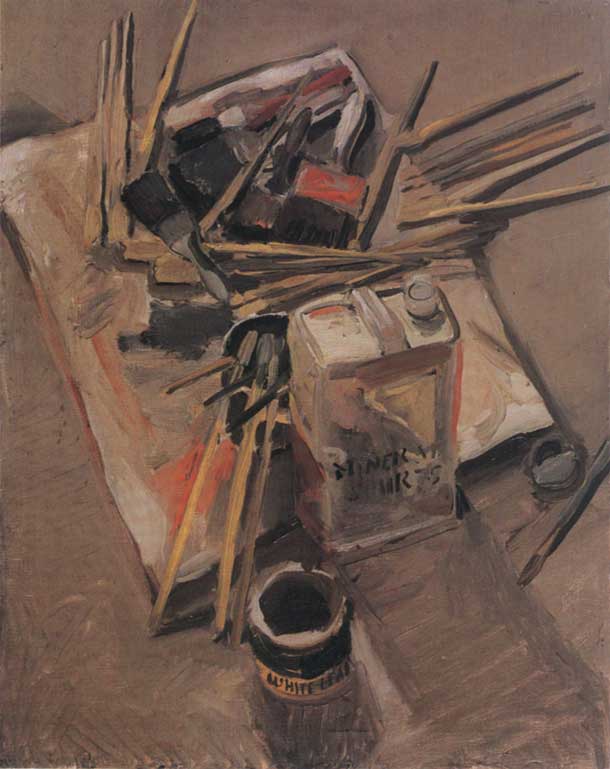
Fairfield Porter, Painting Materials 1949
Fairfield Porter has been on my mind recently which led me to finding some interesting articles, books and links related to Porter’s paintings that I’d like to share.
A recurring theme that often reverberates back and forth inside my head is the notion about painting nature the way you find it. To find the underlying abstract structure of the painting through what is seen rather than imposing a notion of what’s the best order. Of course this doesn’t mean mindless inventory and copy of details but rather looking past the unessential to get to that best line of poetry which captures this particular moment and the experience of looking. The key is keeping it real, that the truthful interaction with nature is often far more inventive, surprising and fresh than repeating ideas of what you think a painting’s proper subject is or should look like. One of my biggest attractions to Fairfield Porter is this honesty before his motif as well as his background parallel-track tunes playing from the ethers of Bonnard, Vuillard, Velázquez and Tiepolo.
Fairfield Porter is reported to have said:
“When I paint, I think that what would satisfy me is to express what Bonnard said Renoir told him: make everything more beautiful. This partly means that a painting should contain a mystery, but not for mystery’s sake: a mystery that is essential to reality.”
The April 2010 essay on Fairfield Porter, “Respect For Things As They Are” by John Ashbery on thisrecording.com is a terrific, must read if you haven’t yet seen it.
A couple of quotes from this essay stood out in particular:
“Order seems to come from searching for disorder, and awkwardness from searching for harmony or likeness, or the following of a system. The truest order is what you already find there, or that will be given if you don’t try for it. When you arrange, you fail.” I think it is in the light of statements like these that we must now look at Porter’s painting, prepared to find the order that is already there, not the one that should be but the one that is.
“You can only buck generalities by attention to fact,” Porter continued. “So aesthetics is what connects one to matters of fact. It is anti-ideal, it is materialistic. It implies no approval, but respect for things as they are.” This last point seems hardest to digest for artists who believe that art is “raw material for a factory that produces a commodity called understanding.” Thus, politically “concerned” artists continue to make pictures that illustrate the horrors of war, of man’s inhumanity to man; feminist artists produce art in which woman is exalted, and imagine that they have accomplished a useful act; and no doubt there are a number of spectators who find it helpful to be reminded that there is room for improvement in the existing order of things. Yet beyond the narrow confines of the “subject” (one one of a number of equally important elements in the work of art, as Porter points out) the secret business of art gets done according to mysterious rules of its own. In this larger context ideology simply doesn’t function as it is supposed to, when indeed it isn’t directly threatening the work of art by trivializing it, and trivializing as well the importance of the ideas it seeks to dramatize.
Another excellent essay is Artes Magazine’s The Art of Fairfield Porter: An American Painter Celebrated a Sense of Place February 2010 By Ken Moffett
(from
Here is a couple of quotes from this article of particular interest…
What Porter wrote about Jane Freilicher can be said of himself: “… when she has to choose between the life of the painting and the rules of construction, she decides to let the rules go. The articulation of some of the figures is impossible and awkward, and though this is a fault, it is a smaller fault than murder.” This quote shows a willingness to depart from received, traditional structure when it is necessary for aesthetic wholeness, but it also shows a great respect for this same structure.
With Porter, this light was explored for its own sake and for what it did to color. Porter made this light softer and warmer and he gave up more to the sensual properties of paint; he was more French. Still, compared to the French — to, say, Vuillard — Porter seems tight, crisp, cool, and spacious. His light is more brilliant, his colors contain more white. Earlier American followers of French Impressionism made of it something narrower and smaller. Porter made it something rougher, brighter, broader, and more distinctively American. He saw his surroundings through the medium of paint and so became a “painter’s painter,” admired for the boldness and sensitivity visible in the aesthetic choices, especially the handling, color, tone juxtapositions, and “weights.” This is very much what Porter’s pictures are about. For all of their tact and understatement, Porter’s mature paintings can be very bold when it comes to painterly values. His pictures seem ordinary, “but the extraordinary is everywhere.”
Two Books on Fairfield Porter’s Paintings
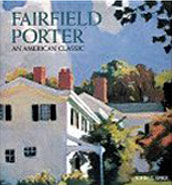
Fairfield Porter
John T. Spike 1996
Spike’s Fairfield Porter is perhaps the best catalog in terms of great reproductions, number of works, and essays. Sadly it’s out of print and the prices are insane but is one of my most cherished art books.
John T. Spike’s Fairfield Porter from Amazon.com
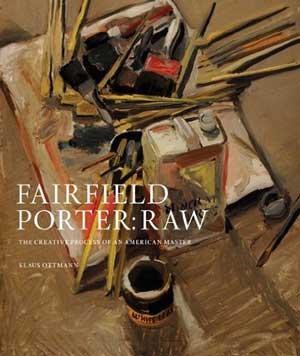
Fairfield Porter Raw [Hardcover]
Klaus Ottmann (Author)
Fairfield Porter Raw on Amazon.com
Fairfield Porter Raw is a new catalog on Fairfield Porter “includes a facsimile from one of the artist’s sketchbooks – this publication accompanies an exhibition at Parrish Art Museum, Southampton, New York, April 11-June 13, 2010 – It features approximately 40 works drawn from the Parrish Art Museum’s extensive holdings of his works, given by Porter’s widow to the Parrish after his death in 1975. In addition to important paintings and works on paper, the Parrish collection includes an unusually large number of works in a less finished state, including some unstretched paintings on canvas and a large number of paintings on boards. Fairfield Porter Raw presents, for the first time, many of these unfinished paintings and accompanying sketches, drawings, paintings on board and ephemera in their raw (unframed) state, offering an unprecedented insight into the creative process of an artist.”
Both of these books, if bought from the links here, will give a small percentage back to help support this site.
Here is another great book of Fairfield Porter’s (I’m just now adding to this post) Edited with an introduction by Rackstraw Downes From the publisher’s blurb… “This new edition of Art in Its Own Terms restores to print a key statement in the ongoing discussion between Modern art and its past, as Porter reviews such figures as de Kooning, Johns, Cornell, Rodin, Cezanne, Leonardo and many others. Equally seminal are his considerations of the relations between art and science and art and politics.” Rackstraw Downes’ introduction beautifully sets the stage for this indispensable and wide-ranging volume.Art in Its Own Terms from Amazon.com
And finally the definitive biography by Justin Spring Fairfield Porter: A Life in Art [Hardcover]
Fairfield Porter: A Life in Art from Amazon.com
A fascinating read that closely examines the details surrounding Porter’s life and art.
Some great links related to Fairfield Porter
Tibor De Nagy Gallery – represents the Fairfield Porter Estate
Oral History Interview with Fairfield Porter 1968
Interview with Justin Spring, Porter biographer and the curator of a new Fairfield exhibit at the Equitable Gallery in New York. Fairfield Porter’s life in art in this hour of The Connection.
Real Audio audio recording by WBUR’s The Connections with Christopher Lydon – April 2000
Excellent biographical essay on the The Art Story
The New Criterion’s article: Fairfield Porter: an American classic
by Hilton Kramer MAY 1983
On the Porter retrospective at the Boston Museum of Fine Arts.

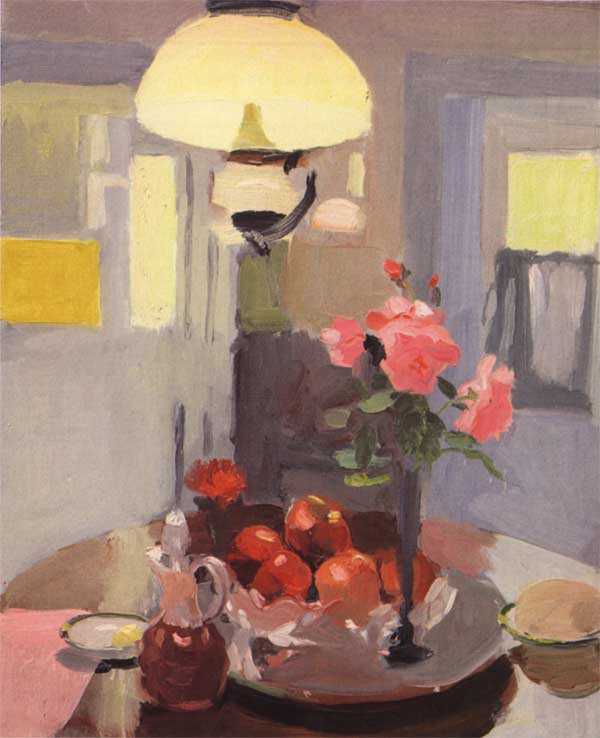
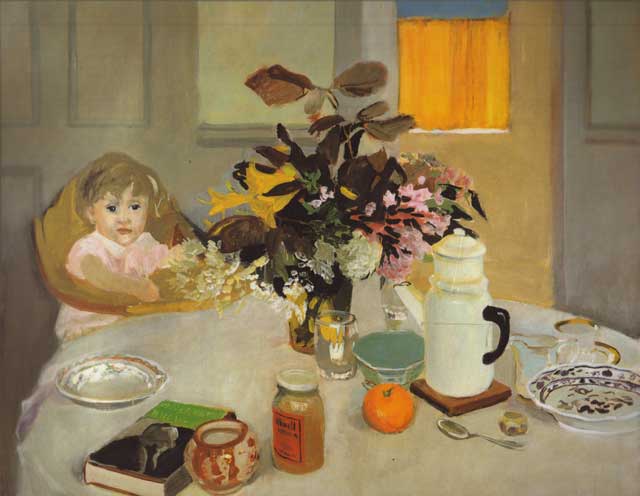
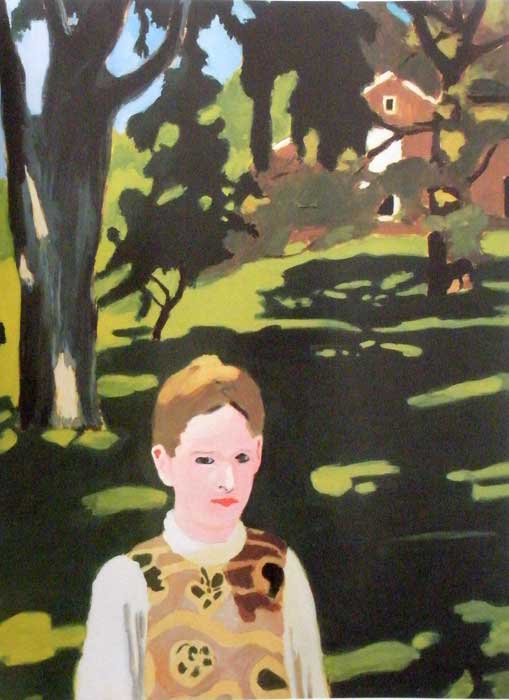
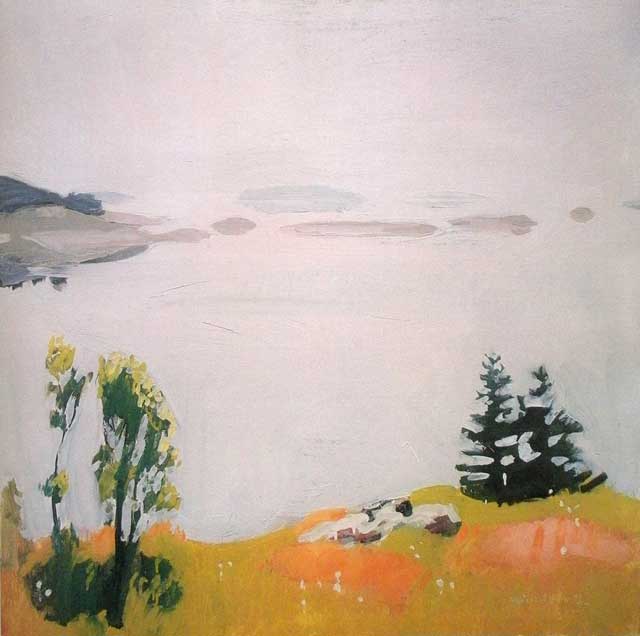
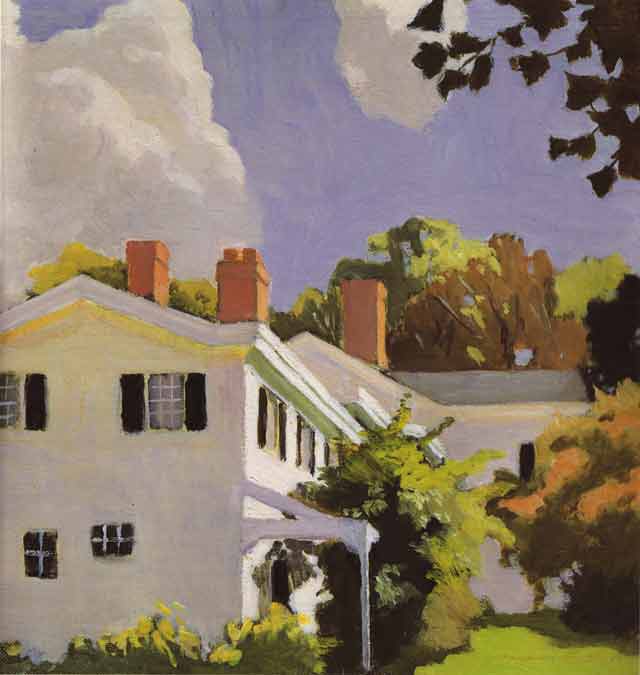
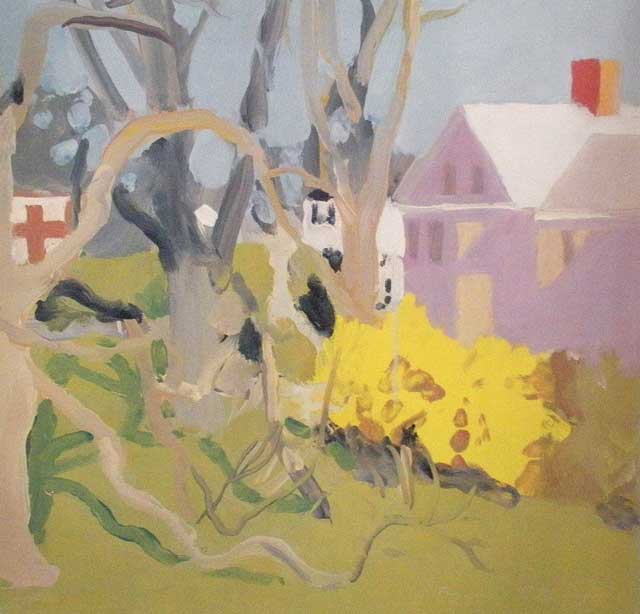
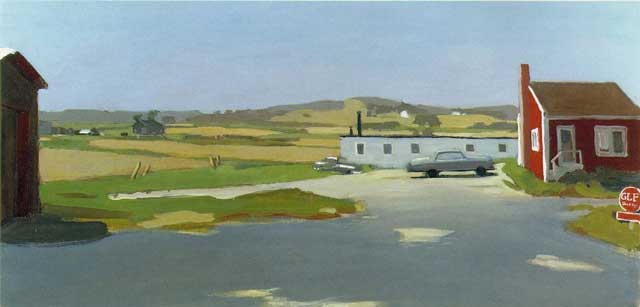
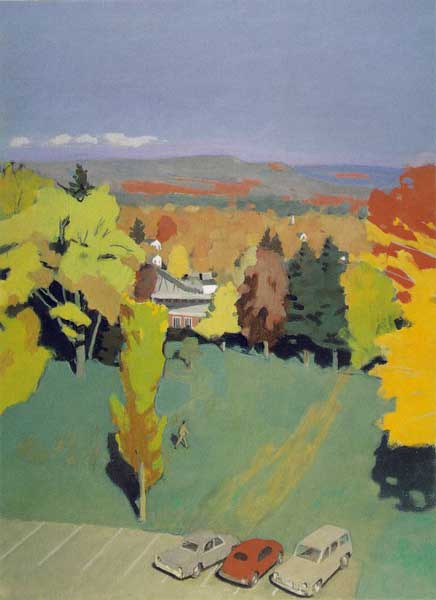






Fairfield Porter – one of my favorites. Thanks for posting. FP was also a great writer. You may want to include his collection of essays: Art In Its Own Terms.
Thanks Steve, good idea about adding his essay collection, I’ll update the article later (along with adding titles, dates, etc to the paintings and maybe add a few more if I get the time.
Also, thanks to Noel for your comment and suggestions. I have often thought of trying for an interview with Rackstraw Downes but to tell you the truth, I’ve thought I would wait until I knew for sure I had some good questions and perhaps wait a bit more for this site to grow more. (Although we do get nearly 15,000 visits a month currently) I’m not sure how approachable he is or agreeable to an interview – but it can’t hurt to try. Keep posted, I may do it yet. The other artists you mention are also worthy suggestions and I’ll put them on my list of painters to check into. Sadly, this site is a labor of love and I don’t always have the time it deserves but as I move forward and perhaps figure out ways for this site to generate income that isn’t too obnoxious, I can approach the needed work with greater frequency and also perhaps pay people for articles. (I’m very open to guest posts and interviews by the way, send me an email if anyone has the desire to do this)
Talking about Porter’s collection of essays, I would love to see an interview or special presentation on the work of Rackstraw Downes.
If it is alright for me to make this suggestion in this thread, I would also like to see articles or interviews on/with Susanna Coffey, Ann Gale and Mary Beth McKenzie. John Winnicott would be cool too.
Thanks for such great presentations and such a useful and inspiring website on perceptual painting.
Hi Larry,
I really do appreciate your website on perceptual painting. It makes me feel connected to a community of artists that shares my love for modern realist paintings of everyday life. The quality of the artists presented are second to none, and I find myself inspired to push harder in my attempts to make better paintings. Over the past couple of years I feel like I have been selling myself short, making uninspired paintings of subjects that have no mystery, and reveal nothing to me in the process. Your website has challenged me to elevate my intentions as a painter, which can falter over time when one feels isolated and misunderstood. Thank you for reminding me that I am part of a large and worthwhile contemporary movement in the history of painting.
Sincerely,
Noel Robbins
Noel, I’d like you to know that your comment made my day! I truly appreciate this feedback, makes this site all the more worth it. Even though I live in large city, I sometimes feel like I’m living in the middle of nowhere from the lack of good galleries and museums that show great painting such as what we see from most of the painter’s featured on this blog and elsewhere. Also, there is an extremely small number of painters here in San Diego, that I’ve met anyway, who are serious “modern” perceptual painters – lots of plein-air type painters who have a more regional focus but very few people painting more contemporary realism from life.
Painting outside in public can be hazardous in such a culturally deprived location, by this I mean – the people walking by and comment on your painting are likely to heap insane amounts of praise (sometimes for just setting up an easel – with a white canvas!) and are quick to applaud any skill in making the thing look like what it is. So the danger is that with all this praise, you start to think you are actually making a great painting just because it looks more real than some other guy’s painting down the road. In the absence of a larger group of peers to help give informed feedback it is important to remind yourself of how high the bar for excellence in perceptual painting has been raised. I put together this blog in part because I need to see what other people are doing and like you put it so well, am also looking for ways to elevate my intentions as a painter and to feel a little less isolated. I hope to read more of your comments. I checked out your website and you have some terrific paintings, I will look forward to seeing and hearing more.
So glad to have found your post.
Some marvelous perceptions and examples.
Thank you!
Have you ever found a recording of Porter speaking?
Would love to hear his voice.
If people are suggesting artists they’d like to see or learn more about, my pick would be the British painter George Shaw. He paints views of the housing estate in Coventry where he grew up, using enamel paint (the kind kids use on model cars and planes) on board. I think he’s terific and (full disclosure) own some of his work. He’s been nominated for the Turner Prize this year, which is a big deal in UK artworld terms.
I have the Fairfield Porter Raw book; its okay if you’re already interested in him but there are a lot of unfinished, not so great or early works reproduced which might give an unfair impression of his achievement to someone who wasn’t familiar with his work. As much as I admire his work, what I also admire about Porter is the quality of his effort, the way painting came slowly to him and how he had to earn and work for everything he got. And also his generosity, the way his work created possibilities for other artists, suggested alternatives to the mainstrean art narrative of his time. Its possible to learn from Porter and remain yourself, the way he learned from deKooning without ever imitating him.
Another good Fairfield Porter resource – at the Archives of American Art, you can look through a bunch of his sketchbooks: http://www.aaa.si.edu/collections/fairfield-porter-papers-8946.
Noel, I checked out your website and that work looks fine! I’d be happy and proud to put my name on some of those…the interior and that long one of the gas station under the blue sky especially. As someone who is groping back to representation after 20 years of painting blobs and stripes (not that some of those blobs weren’t pretty good) this site has been a huge help. Its made me aware of a whole community of artists making really serious, really worthwhile work outside the official cultural narrative, I’ve picked up some useful tips, its helped me feel a lot less isolated and that’s why I can’t thank Larry enough for the effort he puts in. Respect, Larry!
Thanks Larry and Richard for your compliments to my paintings. I have a long way to go, but at least I am enjoying the process, most of the time. Sometimes I rush it too much and finish too soon. When I slow down and focus on the process, and plan to return to the subject as many times as needed, I am more happy with both the time spent at the easel and the results. I am learning, but my thick skull makes it difficult sometimes. :^)
Thanks again for your support and Larry thanks again for all you are doing herewith this website. Your project is going to be known and written about in the future no doubt. I think maybe the Times or Post should do a piece on your blog? I might just make that suggestion to them. Anyway, thanks so much Larry. You truly are contributing to our community in a major way, and keep up the great, great work. I for one find it indispensable.
Cheers!
Noel
Hello Larry,
Interesting that you are brining this topic up as I have been thinking of this continually for the past several months. In teaching composition to beginning students in painting courses, I am actually beginning to find pictorial composition principles repetitive and limiting to artistic vision. About ten years ago I completed several panoramic landscape drawings on site, one of which was seventeen feet long. These drawings took me months to complete, but I had undertaken no preliminary sketches or any real thought about ordering design elements in the picture plane to determine a larger formal arrangement,, I simply observed the environment as carefully as possible and allowed it to reveal itself to me as I progressed across the drawing, I did not try to control it, contain it or idealize it pictorially. This process was so liberating and the result very interesting. I am a bit tired of trying to make everything try to resolve harmoniously inside a rectangle and believe that exploring new processes may lead to unexpected and potentially innovative results. Thanks for posting this, I actually had never though of Porter as holding any of these ideas.
Hi Andrew, Good to hear from you, sorry to be so long in writing a reply to your comment – we should get together again sometime. Your comment about composition is very interesting, I’ve always been suspicious of compositional doctrines and schemes that dictate how to balance the painting or lead the eye through some prescribed path that keeps the eye inside the painting, and if you don’t the viewer’s gaze will “quickly run off” and onto to the next guy’s painting. Boring painting happens for many reasons but not obeying the academic “rules” of composition isn’t one of them. I do think it is worthwhile to learn what various schools of thought have to say about composition in a similar way to it is worthwhile to have some understanding of anatomy and perspective but when I’m actually painting I want to just think about the painting in front of me and figure it out as I go.
Larry you managed to post a whole bunch of some of my very favorite Fairfield Porters. It reminds me that at his best, Porter was amazingly fresh. He reminds me so much of what I imagine Vuillard would have been like if he was reincarnated to the mid 20the century and chose to spent more time outdoors.
Hi Philip, Thanks for you comment, I agree about this connection with Porter. Vuillard is among my top ten favorite painters, I saw a big retrospective of his paintings at the Brooklyn Museum years ago that made a very big impact on me. I just read your blog post from a few days ago comparing Porter and Hopper’s different ways of seeing in painting. Great post.
Andrew,
I agree with you completely. I also teach 2-d design principles in my painting classes, but I always tell my students to be aware of what it is that they are trying to communicate, and to let the composition come out of that. Rackstraw Downes gave a terrific lecture in Marfa, Texas at the Chinati Foundation regarding composition based on objective study of a place. He wrote the introduction for the Fairfield Porter collection of essays, and he has written several other works on his own ideas. His lecture, titled Turning the Head in Empirical Space, is printed in a monograph on his work. One of the things he said which I will always remember is that he wants to paint landscape in a way that is not romantic, but from a thought more like how a farmer must think about his farm. He wrote that he lets the composition find the edge of the canvas. It is a kind of anti-composition I think?
Consistent with Downes’ paintings and writings is a wonderful writer on landscape who produced a magazine back in the fifties on the history and sociological aspects of landscape named J.B. Jackson. You can find him on Wikipedia here: http://en.wikipedia.org/wiki/J._B._Jackson He has influenced my work for years, even though lately I have been dropping the ball by considering compositional elements and principles too much.
Thanks again to Larry for this blog. It gives me impetus to ratchet up my game a notch or two.
It is a shame that FP painted during that period. He was overshadowed and never really garnered the attention he deserved. He had a great way of taking such a simple, traditional viewpoint and making it modern while not jeopardizing the harmony of the picture. His work really shines in person!
Hi Larry,
Thanks for the FP article. I read the Spike book cover to cover in about 1993, so I revisited it as you have done. My reaction was very different this time. I also read all of his writing I could find way back when and just the reminder of them is good to touch upon again.
If you need to raise money for this web site you could ask for a yearly donation, $5 -$15, set up pay pal if people are so inclined. You do us all a real favor with this web site and probably many would be willing to send a contribution to support it.
Valerie Cordaro
Great post Larry! Always great to see some Porters! and all the links will be great. thanks!
Please put a link to the essays Art on Its Own Terms by FP – i’ve been wanting to get that but haven’t had the chance yet.
Noel – there are some things in the works but they’ll be a bit down the road and there are no promises. Hopefully we’ll soon have an interview with Stephanie Pierce who studied with (among others) Ann Gale and does some really wonderful work.
Thanks Neil for reminding me to add the book links…I just made that addition and added Justin Spring’s biography as well, another great read. Justin talks at length about this biography and Fairfield Porter in the NPR interview that I linked to.
Neil,
I look forward to the interview with Stephanie Pierce. Her work is indeed wonderful! I am so impressed with the figurative painters working these days. So open and intense! It’s like their drinking some magic potion, like Giacometti juice, or something. And how much love for painting is embodied in their expressions!!! I absolutely love this blog!
Thank you Neil and Larry!
Noel
I was just thinking again about the whole anti-composition idea in figurative painting, and how Antonio Lopez Garcia explained to a couple visiting his studio, in the documentary film Dream of Light, that he doesn’t play any aesthetic games, but rather creates presence by placing his subject in relation to symmetry. It makes me think of Downes’ idea of letting the composition find the edge of the picture plane. Both of these painters are of the same generation, and they both have built incredible bodies of works based on an anti-formalist, anti-abstraction stance. Their generation followed Porter’s, and Porter embraced abstraction, but not as a type of game. For Porter abstraction was a structural way into Realism. His abstraction was based on simplified light and shadow patterns, which is classical. Think of Tiepolo’s wonderful ink drawings.
I wonder how many perceptual painters out there now have a distaste for formal play? How much does aesthetics have to do with the working process of contemporary perceptual painters like Gale, Coffey, Bok, Kanevsky, etc.
One great aspect of contemporary perceptual painting is its life under such a big tent that allows for room for widely divergent approaches and philosophies. Of course there are lots of painters working from life who are obsessed with the geometry of the painting and go to great lengths to explore ways to relate what is seen to how it can best fit into the four walls of the rectangle. Francis Cunningham that I just recently posted about talked about his concerns about this in one of his videos on his blog. I suspect many still-life painters in particular tend to lean towards the geometric organization – but also work that out with the organization of the the still-life subjects before painting. When you are painting cityscapes and such like Rackstraw then you are far more likely to respect what is seen and not change stuff. Sometimes the “anti-formalist”/”anti-abstraction” painters (I’m not sure I understand completely or agree with what is meant by this label) are just as obsessive like with Lopez’s and Uglow’s perfectionist search to relate every thing to the grid and plumb-lines. But perhaps it’s this obsession itself that often makes the work so fascinating. Even though I would never go out and mark up leaves on the quince tree to line them up on a grid (like in the Dream of Light) I marvel at the fact there are such people in the world.
Israel Hershberg talked in his interview about how wild and heated arguments would get years ago in painter’s forums (real life) from various camps and of course there has always been the running battle in different forms with the Poussinistes Vs. Rubenistes and in a way I wonder if what we are talking about isn’t some variant of that. I have often wanted to avoid taking sides and see the good and bad from both sides but sometimes I wonder if the passion of the belief itself isn’t a driving force in making one’s art exceptional. If you’re too nice, objective and civil – you’re likely to make boring paintings!
Larry,
I don’t think the idea of using design theory to contrive painting narratives is necessarily in opposition to any other way of composing. Part of being postmodern is recognizing the failure of dualistic attitudes towards artistic expression, as in life. One of the things that interests me most about our current art environment is the strategies of juxtaposition and hybridizing in painting. It makes writing about it very difficult. On top of that my language is undoubtedly going to be confusing at times, as I am from Texas where language is butchered on a daily basis, although I don’t think I am quite as bad as our last president. 🙂 By “anti-composition” I mean artists that are not interested in changing any part of the visual reality that spreads naturally in front of their eyes for aesthetic reasons. I don’t mean to imply that formal interests in painting are somehow less important either. I personally love all of it. I also don’t think this involves the whole romantic/classical dialog. While still being culturally significant, the notion of having to chose to make a fleshy intuitive painting or a crisp intellectual one seems far outdated to me. Some folks choose I guess, like Jacob Collins and other contemporary classically oriented painters? I find myself making decisions for my own work based on feelings that I could describe as either romantic or classical respectively, but those labels just don’t seem enough to say they fit. I think we are influenced by these cultural codes as painters, but our work demands an acceptance of extreme ambiguity in our era. It isn’t necessarily a case of watered down the art to accept all the influences that press on one’s work. That is more than likely where the good stuff is found.
I know I am not very good at articulating myself through words, so please accept my apologies for any confusion I may have, and still might be, causing you. I guess it is best if I just shut up an paint! :^)
Noel
“sometimes I wonder if the passion of the belief itself isn’t a driving force in making one’s art exceptional. If you’re too nice, objective and civil – you’re likely to make boring paintings!”–
I agree, Larry, and i think that having a strong opinion is huge in terms of the drive to make paintings, and decide what your artistic goals are–after all, you decide where the bar is you are trying to get over, and if it gets set low, then the results are boring. Light in an empty room isn’t very interesting if it doesn’t evoke a passionate response from the painter, but if it does, it can sing!
I also think that this is a reason why artists are often so passionate in their dislike of certain other artists’ work–not because they are thwarted or angry individuals, but because a painting is a statement of values–and some people value authenticity and simplicity, and some value clever or slick dazzling solutions, utterly predictable, full of contrived feeling, “a mile wide at the mouth and an inch deep”.
I really enjoyed the “Art in it’s Own Terms” collection, and one of the the things that struck me most is Porter’s strong confidence in his viewpoint. Downes’ “Turning the Head in Empirical Space” essay is very interesting too, and I challenge anyone who subscribes to the silly idea that representational or traditional painting is unintelligent to read that essay and keep their prejudices intact.
Thanks as always for the interesting discussions and great images!
I’ve been a fan of Fairfield Porter for many years, and I have everything published about him, including the books you mention. The last show of his work that I saw was back in 2000, and it was wonderful. I recently ran across a quote of his that I particularly like: “It may be that to separate pleasure from an object is too hard a thing to do, and that abstract pleasure, like abstract taste or abstgract love, is not for ordinary mortals.”
I’ve been enjoying your blog, and especially the chance to see a couple of unfamiliar Porter paintings. His unflinching directness motivates me, along with his fabulous palette.
wow wow wow just stumbled upon this site…porter has been my mentor for 20 plus years! we even are lucky enough to have both a lithograph of his daughter lizzy with his thumb print on it as well as a silkscreen…i am thrilled to be reading thoughts by other painters————great company! many thanks!!!!!!! susan
Thanks for the post. I was also thinking about FP lately with regard to a shift in my own work from abstraction to representational/figurative. I was voraciously reading up on him when I came across your post. Love reading everyone’s comments, particularly Noel’s mentioning how FP “lets the composition find the edge of the canvas,” and the idea of anti-composition.
Excellent survey of what’s available on Porter. He’s my favorite 20th century American painter, and remains unjustifiably under-regarded, partly I think because art was hijacked by conceptual concerns during the decades when he achieved a real mastery of his medium, the 60s and early 70s. He simplified his images to the point where it often seems as if his paintings were dashed off in an hour, and yet when I saw one of his large canvases here in Rochester at the Memorial Art Gallery, an extremely simple, nearly monochrome study of an illuminated horizon, the paint lay heavy and thick on the surface, indicating long labors to pare his image down almost to the level of pure abstraction. Porter was always, always, focused on the quality of the paint, the surface, the almost tactile sensation you get of how the medium sits on its support, and yet, at the same time, his images offer distinct, elusive, global sensations of a particular time and place, a season, even a time of life. He tapped deeply into the mystery of how looking at properly handled oil paint can communicate a different kind of awareness by doing an end run around reasoning and words. For all that evident labor with paint, his finished work offers a real delicacy and a light touch in the way he conveys the world “just as it is.” You are in a unique realm, Porter’s world, when you look at one of his paintings, and yet, at the same time, you recognize much of your own world in it. For all that, his images also work as incredibly beautiful, subtle, musical compositions of color. At one level, he simply found his own, new way of arranging color on a flat plane so that, as he says somewhere, the painting gives you the sensation of “seeing something for the first time.” With him, that can mean even the sensation of seeing certain colors for the first time. Yes, he’s indebted to Vuillard and Bonnard, and Velasquez, but, for me, he’s as close as America has ever gotten to Matisse.
Fairfield Porter was not overshadowed during the l950s. He was in the middle of everything important going on in New York: exhibited often at Tibor deNagy, was in all major group shows, reviewed and wrote lengthy articles for Art News when it was a serious magazine for artists under the editorship of the great Tom Hess. Porter always had a loyal group of collectors, and most artists I knew then regarded his work very highly and were influenced by his writing. Although AbEx was important, there
was also an equally important and regarded group of representational painters like Jane Wilson, Jane
Freilicher, Lois Dodd, Robert DeNiro (father of), etc. If you can find issues from the l950s you will
see the wide variety of excellent painting being shown then.
I agree with Lydia Finkelstein that Porter and many others in the New York School played a vital role during that time, as posterity has borne out. De Kooning was instrumental in getting Porter exhibited initially–so he wasn’t lacking in appreciation from those who knew his work. And his highly-regarded essay/reviews on art certainly helped raise his profile. Yet I do think that abstract expressionism and the movements that reacted to it in the 60s attracted far more attention from the general public than the equally significant work of representational artists who were painting during that period, creating work that evolved naturally from earlier tradition where AbEx and other later movements appeared to be more radical leaps. Obviously I wasn’t arguing about the actual “importance”of the work, simply remarking on what was regarded as “new” and therefore worthy of attention from the general public.
I absolutely loved Porter’s observation on political art. It’s a plague.